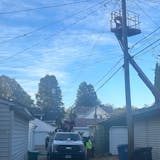Minneapolis has regained the top spot in a national park-scoring comparison, edging ahead from last year's tie with St. Paul because it counted its basketball hoops correctly.
The Trust for Public Land, which scores big cities on various park measures, on Thursday awarded Minneapolis 86.5 points and bragging rights for the top score in 2016 among the nation's 100 most populous cities. St. Paul ranked second at 82.5 points.
The two cities tied for the top spot in the 2015 ranking, but it turns out that was due to a Minneapolis data flaw, according to trust researcher Abby Martin.
Minneapolis had been reporting its full-court outdoor basketball courts, she said, rather than the total number of hoops, including half-courts, as specified by the trust. Correcting that flaw more than doubled the number of hoops, giving Minneapolis several points more than St. Paul overall. But St. Paul still tops Minneapolis in basketball with 4.2 hoops per 10,000 residents, compared with 3.9.
Minneapolis has led the national rankings since they were expanded to the 50 most populous cities in 2013, but it was tied by St. Paul last year when the list expanded to 75 cities. The list grew to include 100 cities this year.
"We're excited, as always. It's always fun to be No. 1," said Park Board President Liz Wielinski.
Mike Hahm, St. Paul's park director, was gracious about losing last year's shared top status. "We applaud the very competitive process which sets a high standard for what a successful park system looks like, and congratulate our friends across the river for continuing to raise that bar," he said in a statement.
Minneapolis and St. Paul retained their relative strengths as park systems, well ahead of the other big cities on all measures. Residents of both cities pay enough to gain a top score for investing in parks, with $224 per capita in Minneapolis and $212 per capita in St. Paul. Both registered a near-perfect score for the shares of residents within a half-mile of a park, with St. Paul's at 96 percent and Minneapolis' at 95 percent.


